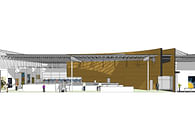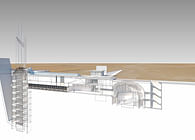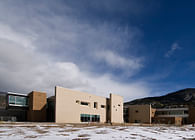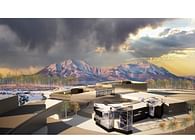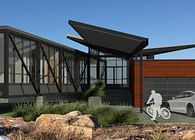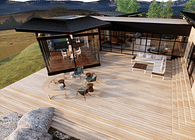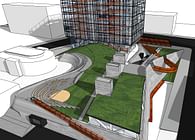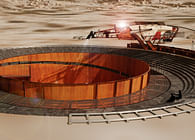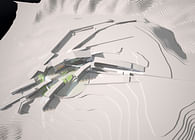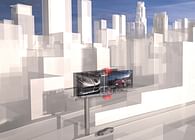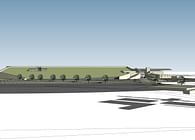
Colorado Springs, CO, US
PROJECT STATISTICS (basic data - exhibit elements in progress) Location: 11034 Pete V. Domenici hwy - El Paso, Texas, USA and Ciudad Juarez, Chihuahua, Mexico
Built or Unbuilt: Unbuilt (as a prototype being developed by the US Immigration Services and Homeland Security Services through the GSA, it’s development was cancelled in September of 2008 due to changing US border policies).
Typology: Institutional New Construction or Remodel/Addition: New Construction
Materials: 1) ground granite on cast-in-place concrete (CIP), 2) rammed-earth wall construction, 3) HSS, W- shape, and steel trusses, 4) PPG structural glazing, 5) insulated metal panels (IMP), 6) fiber-resin rain-screen, 7) 2’x4’ honed porcelain floor tiles
Completion Date: unknown Size: 15,286 SF (total interior programmed space)
Statement of Design Approach: Different than the more familiar automotive port-of-entry stations, a work- program border crossing station is non-automotive, with participants physically walking through the building after being driven to and from their place of employment via public or private transportation.
The project is designed to reflect it’s programmatic intent, meaning, the driving ideology behind it’s stance on foreign policy as seem through it’s borders. To this end, the project seeks an optimistic, trusting solution, where specific objects such as border, fence, barrier, and iconographic symbols institutionalism are muted, if not subsumed. The design strategy, therefore, was one of erasure. In this way the project acts as a representation of trusting, collaborative foreign policy, unfortunately overturned by over-riding political forces after years of battle. It is our hope that this project, or one of similar intent, is resurrected in coming years.
narrative: Architecture, at it’s core, is a social science, as it often reflects the values and intents of those who create it. The project provides the necessity of it’s program as a contractual fiduciary, but as a professional fiduciary, it accesses a larger framework of issues as well.
The project proposes an Earth-cut for the crossing. The building itself is buried and somewhat invisible, leaving only a residual trace as evidence of it’s occupation. The power of the project is garnered by a submersion into the earth, a scar, rather than the occupation of a defined territory by an object. The architecture, therefore, is an architecture of absence. This reversal of object and place is what initially interested us about this project, and in as much, provided us with a framework for execution.
The need to demarcate a division line is more a necessity of political policy than anything that can inspire a responsible architecture of our current time. The client’s ambition was that this (hopefully) ephemeral building typology would dissolve as social, political and economic ideologies evolved forward. The Earth-cut should, in time, fill with the sands of disuse, with only traces remaining - the remnant traces of a past political burden. For now, “X” will mark the spot.
The project is highly processional, as the typology and program would dictate. However, the process is reversed and inverted. The functional imperative is not one of dictation, although that happens, but rather of trust. The project is visible during the day only by the obvious break in the fence - it literally disappears into the earth - but is highly visible at night by the four light towers.
The cutting tracers found upon the site channel light and water into the project, but their symbolic purpose is in represent the notion of rendezvous, particularly from 30,000 feet. Symbolically, the water at the actual crossing represents the Rio Grande, the river that was historically crossed, often with some hazard. Here, the water is a peaceful underground seep. It is shallow and reflective The pathway across makes you pay attention as you walk, much as the Earth-cut heightens your awareness of path as you subjugate the ground plane. It is another world below the radar.
Borders are required by a nation and must be maintained. There are rules and regulations for crossing national boarders, and this project represents those. However, it was the intent of the GSA during this time-frame to reduce the aspect of ‘barrier’ to our neighbors, and rather to promote an encouragement to follow prescriptive guidelines between nations.
It was recognized that a physical, obvious barrier was only necessary because of perceived inequities between nations. In recognizing the flow of illegal immigration into the US from it’s neighboring Mexico, regardless of the presence of physical barriers and military solutions, the complex, nuanced inter-relationship between nations in our currently emergent Global Community is also recognized.
This project seeks to reveal how architecture can directly reflect it’s programmatic intentions, not of just space and functional purpose, but in cultural and political intent as well.
design process: as the prototype would suggest, there are two functionary structures on opposite sides of a path. however, we chose to bury the buildings, leaving only trace symbols of their existence to be seen from the barren landscape. various Earth-cuts channel through the path, accentuating the idea of path itself while subsuming the idea of a definitive event.
as an inversion to the standard ‘object-based’ strategy, the project’s organizational diagram is based upon foreign policy as a kinetic determinant, while its annunciation is through its site plan rather than its floor plan.
the agency spaces are 6,000 SF each, with common waiting room, toilet facilities, participant processing rooms, communications room, break room, mechanical, and storage as adjunct spaces.
the processional path (Earth-cut) requires participants to pass through both sides for processing, crossing the symbolic river at the mid-point of both path and process. the participants reverse the sequence upon return.
both agencies are submerged below grade, both have identical programs, yet each are defined by different spacial treatments of both light and breadth.
both sides of the processional path re- emerge and then terminate at grade, where a transportation hub is provided.
while each agency program is identical, each has its own DNA of spatial treatment based upon its user’s internal approach to the project’s intent.
Status: Unbuilt
Location: El Paso, TX, US
My Role: Principal, Lead Design Architect, Project Architect
Additional Credits: Brian Elyo, Ryan Ekstrom, Richard Mapes

